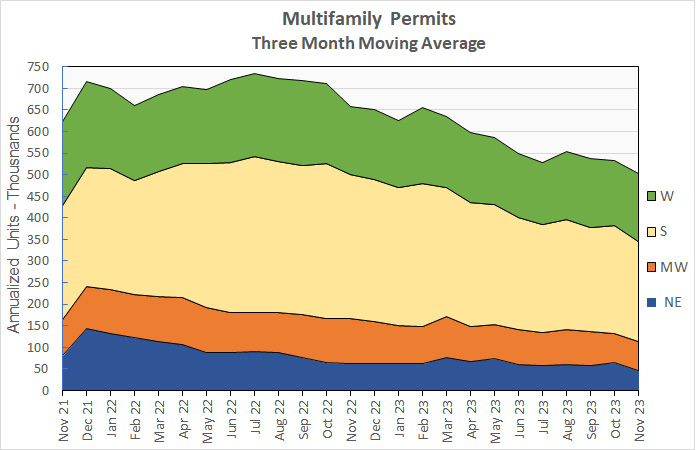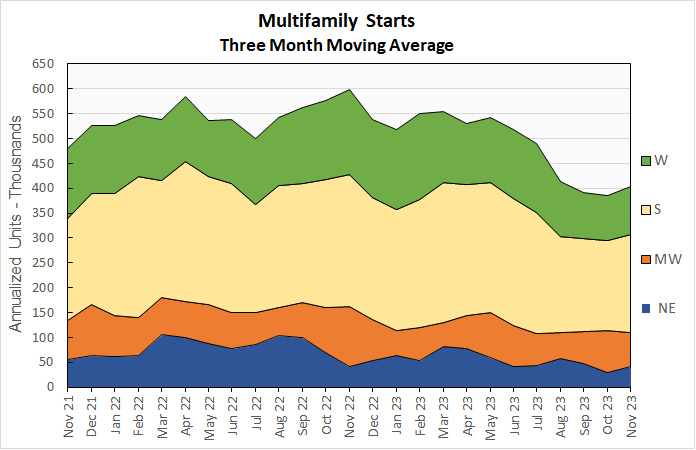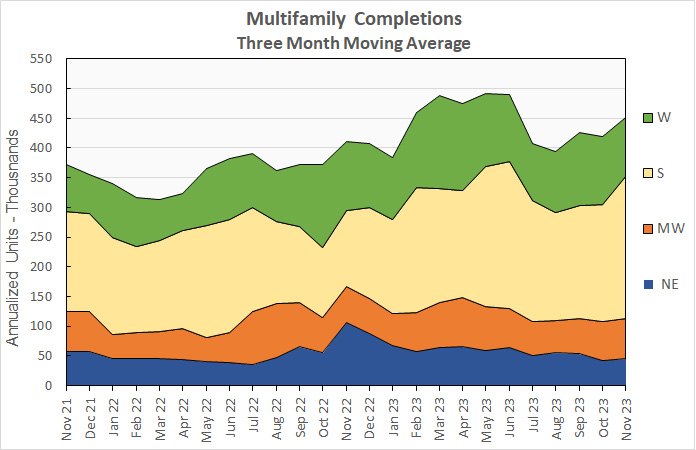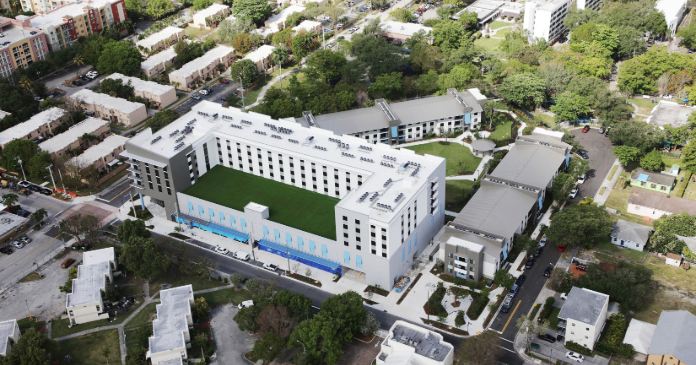The Census Bureau’s new residential construction report for November stated that multifamily construction starts and completions were up from the levels reported last month. However, the number of multifamily construction permits fell.
The number of multifamily units under construction ticked down slightly from October’s revised level. Census reports that the number of multifamily units under construction has fallen gradually for 4 months in a row after peaking at 1,001,000 units in July.
The report on single-family housing construction showed that, on a seasonally adjusted basis, single family permits rose 0.7 percent, starts jumped 18.0 percent, while completions fell 3.2 percent. The reported number of single-family units under construction rose 13,000 from the revised level of the month before to 680,000 units.
Multifamily housing permits continue decline
The number of permits issued for buildings with 5 or more units in November was reported to be 435,000 units on a seasonally adjusted, annualized basis. This was down 9.6 percent (46,000 units) from October’s revised (+12,000 units) figure. November permits were down 21.3 percent from the level recorded in November 2022 and were also down 17.9 percent from the trailing 12-month average.
In addition, 49,000 permits were issued in November for units in buildings with 2 to 4 units. This was up 1,000 units from the revised (-2,000 units) figure for October. November permits for units in buildings with 2 to 4 units were down 9.3 percent from the year-ago level and were down 5.8 percent from the trailing 12-month average.
Regional data for multifamily housing is only reported for structures with two or more units. “Structures with 5 or more units” is not broken out as a separate category. Since the regional data is highly volatile and is frequently revised, it is examined here based on three-month weighted moving averages. This averaging helps smooth out the month-to-month variations in the data.
Nationally, the three-month weighted moving average for permits issued for multifamily housing in November was down 5.6 percent from the level in October and was down 23.7 percent from the level of November 2022. The three-month weighted moving average for permits came it at 503,000 annualized units.
On a month-over-month basis, the three-month weighted moving average for multifamily permit issuance was up 4.1 percent in the West and 1.7 percent in the Midwest. Permit issuance fell 7.5 percent in the South and 25.6 percent in the Northeast.
When compared to year-earlier levels, the three-month weighted moving average of permits issued was unchanged in the West but was down 25.6 percent in the Northeast, 31.0 percent in the South and 34.7 percent in the Midwest.
The following chart shows the three-month weighted moving averages of permits by region for the last 25 months.

Multifamily housing construction starts higher
The preliminary November figure for multifamily housing starts in buildings with 5 or more units was 404,000 units on a seasonally adjusted, annualized basis. This was reported to be up 33,000 units from the revised (-11,000 units) figure for October.
Compared to the year-earlier level, multifamily housing starts in buildings with 5 or more units were down 33.7 percent. The reported starts figure was 15.8 percent lower than the trailing 12-month average.
Multifamily housing construction starts (two or more units per building) in November were up 4.9 percent from their October level for the country as-a-whole, based on three-month weighted moving averages. Starts fell 17.7 percent in the Midwest but starts rose 8.3 percent in the West, 8.6 percent in the South and 36.3 percent in the Northeast from the levels of the month before.
The three-month weighted moving average of starts was down 32.6 percent for the country-as-a-whole on a year-over-year basis. Compared to November 2022, starts were down 0.8 percent in the Northeast, 26.3 percent in the South, 42.7 percent in the Midwest, and 43.0 percent in the West.
The following chart shows the three-month weighted moving average of starts by region for the last 25 months.

Multifamily housing completions also higher
The preliminary November multifamily housing unit completions figure in buildings with 5 or more units per building was 472,000 units on a seasonally adjusted, annualized basis. This was reported to be up 26.5 percent (99,000 units) from October’s revised (-35,000 units) figure.
Compared to the year-earlier level, multifamily housing completions in buildings with 5 or more units per building were up 9.5 percent. Compared to the trailing 12-month average, completions were up 10.3 percent.
For the country as-a-whole, multifamily housing construction completions (two or more units per building) were up 7.5 percent month-over-month, comparing three-month weighted moving averages. The three-month weighted moving average of completions was up 21.8 percent in the South, 7.1 percent in the Northeast and 2.8 percent in the Midwest. However, completions fell 14.2 percent in the West.
On a year-over-year basis, the three-month weighted moving average of completions in buildings with 2 or more units per building was up 9.8 percent nationally. Completions were up 88.0 percent in the South and 12.7 percent in the Midwest. Completions fell 15.4 percent in the West and 57.6 percent in the Northeast.
The three-month weighted moving average of completions by region for the past 25 months are shown in the chart below.

The number of multifamily units reported to be under construction fell in November. Census reported that there were 988,000 units under construction in buildings with 5 or more units per building on a seasonally adjusted annualized basis. This was reported to be down by 1,000 units from the revised level of the month before. It is 7.9 percent, or 72,000 units, higher than the number of units under construction one year earlier.
All data quoted are based on seasonally adjusted results and are subject to revision.













